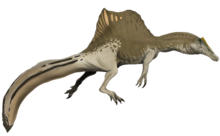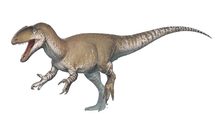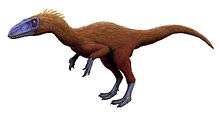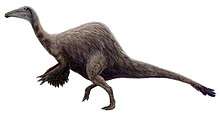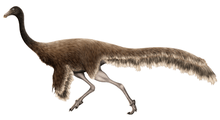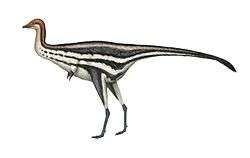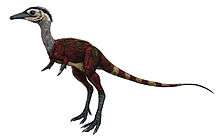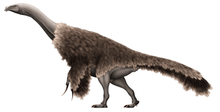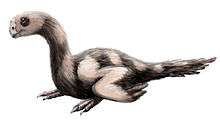Averostra
Averostra, or "bird snouts", is a clade that includes most theropod dinosaurs that have a promaxillary fenestra (fenestra promaxillaris), an extra opening in the front outer side of the maxilla, the bone that makes up the upper jaw. The two groups of averostrans, Ceratosauria and Tetanurae, both survived into the Cretaceous period. When the Cretaceous–Paleogene extinction event occurred, ceratosaurians and two groups of tetanurans within the clade Coelurosauria, the Tyrannosauroidea and Maniraptoriformes, were still extant. Only one subgroup of maniraptoriformes, Aves, survived the extinction event and persisted to the present day.
| Averostrans | |
|---|---|
 | |
| Skeleton of a juvenile Ceratosaurus, Dinosaur Discovery Museum | |
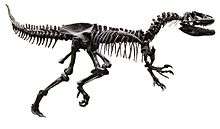 | |
| Skeleton of Allosaurus fragilis | |
| Scientific classification | |
| Kingdom: | Animalia |
| Phylum: | Chordata |
| Clade: | Dinosauria |
| Clade: | Saurischia |
| Clade: | Theropoda |
| Clade: | Neotheropoda |
| Clade: | Averostra Paul, 2002 |
| Subgroups | |
Definition
Averostra was named by Gregory S. Paul in 2002 as an apomorphy-based clade defined as the group including the Dromaeosauridae and Avepoda with (an ancestor with) a promaxillary fenestra.[1] It was later re-defined by Martin Ezcurra and Gilles Cuny in 2007 as a node-based clade containing Ceratosaurus nasicornis, Allosaurus fragilis, their last common ancestor and all its descendants.[2] A 2020 monograph supported the classification of very early large Jurassic theropods such as Dilophosaurus as not members of the group, but related to basal members. [3]
References
- Paul, 2002. Dinosaurs of the Air. The Johns Hopkins University Press, Baltimore and London. 460 pp.
- Ezcurra M.D. and Cuny, G., 2007. The coelophysoid Lophostropheus airelensis, gen. nov.: A review of the systematics of "Liliensternus" airelensis from the Triassic-Jurassic outcrops of Normandy (France). Journal of Vertebrate Paleontology. 27(1), 73-86
- Marsh, A., & Rowe, T. (2020). A comprehensive anatomical and phylogenetic evaluation of Dilophosaurus wetherilli (Dinosauria, Theropoda) with descriptions of new specimens from the Kayenta Formation of northern Arizona. Journal of Paleontology, 94(S78), 1-103. doi:10.1017/jpa.2020.14



